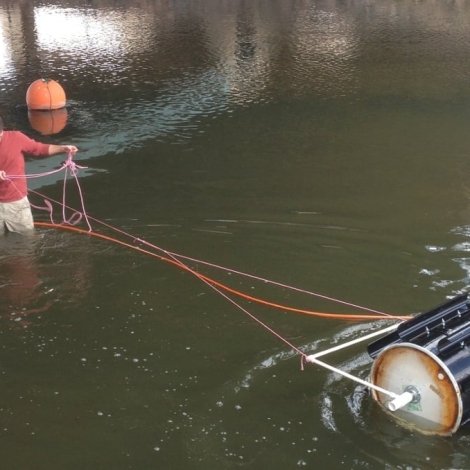Photo courtesy of Dirk Long
Some farmers living along streams and rivers in Niger carry water to their crops by hand. They may not be aware of it, but they have the flowing power supply for a simple pump. A good design, parts and training in upkeep may be all they need to irrigate their land and possibly double their crop production.
A new startup called Current Pumps has a plan to help. The company’s engineers have designed a low-tech pump with few moving parts. It floats in a stream and moves water powered entirely by the current. Current Pumps plans to introduce 20 of its pumps to farmers in Niger and show them how to operate and maintain the devices. A contact in the country will help farmers make repairs and keep the pumps running.
To fund the first phase, Current Pumps has launched an Indigogo campaign. The company seeks $25,000 by January 8.

The Archimedean Screw (left) draws water along its threads as it turns. A spiral pump, based on that concept, scoops water into an open end and pushes it toward the center. Source: Wikimedia Commons | Archimedes’ screw | spiral pump
How the pump works
The Current Pump is a new spin on an old concept. The design has roots in Archimedes’ screw, a sloping column with one end in the water, the other end out, and it lifts water along the threads of a large turning screw. Later, spiral and coil pump variations on the design tilted the screw on its side to allow for a device that spins along a horizontal axis. H.A. Wirtz, credited with developing the spiral pump in 1746, built an upright spiral that scoops water in a large open end as it spins.
Each successive turn pushes the water closer to the center.
Inspired by that idea, the Current Pump coils a tube around the inside of a spinning, floating 55-gallon drum. The water pushes to the end of the coil where it passes through a hose. The pressure can lift the water to a farm that is up to 40 feet (12 meters) above the water source (these are low-head pumps).
“Our pump really fits a certain niche. In some cases there will be other technologies that are more appropriate, but where there is a stream nearby to use our design, we believe it will be the best option. The advantages it has over other designs such as gas pumps, hand pumps, treadle pumps and the other technologies in the space is that it requires no user work input, no operating costs and minimal maintenance, all while being low costs and in the reach of farmers by use of micro-lending,” Dirk Long, who directs technology research and development at Current Pumps. Long has worked in Mexico and Niger in construction and drilling water wells. His long-term vision for Current Pumps includes the possibility of opening manufacturing operations near the towns where the pumps will sell.
Photo courtesy of Dirk Long
Evolving design
Long and his team are experimenting with design modifications such as different sized paddles and pumping mechanism to best take advantage of the varying conditions in each stream.
“Ultimately, the pump technology can be catered to fit the stream, but we are trying to settle on a design that is applicable in the widest range as possible,” Long says.
Sustainable solutions
One of the problems with pump projects in developing countries is that sometimes pumps break but nobody can fix them. Parts are unavailable or nobody knows how to make a repair, so they idle there rusting and unused.
“That is definitely a big concern and in the well drilling I’ve done in Niger we take care to ensure local access to repairs and an in-country contact to monitor and coordinate well drilling and maintenance. For this project we initially plan to use a similar approach to ensure access to maintenance. We are also designing the pump to have minimal moving parts and simplify the failure modes so that repairs are simple and rare,” Long says.
To support Current Pumps, you can make a donation at their Indigogo page.



Hi
Any chance you manufacture these for South Africa?
I know a community that could benefit from a few of these
Love the design!